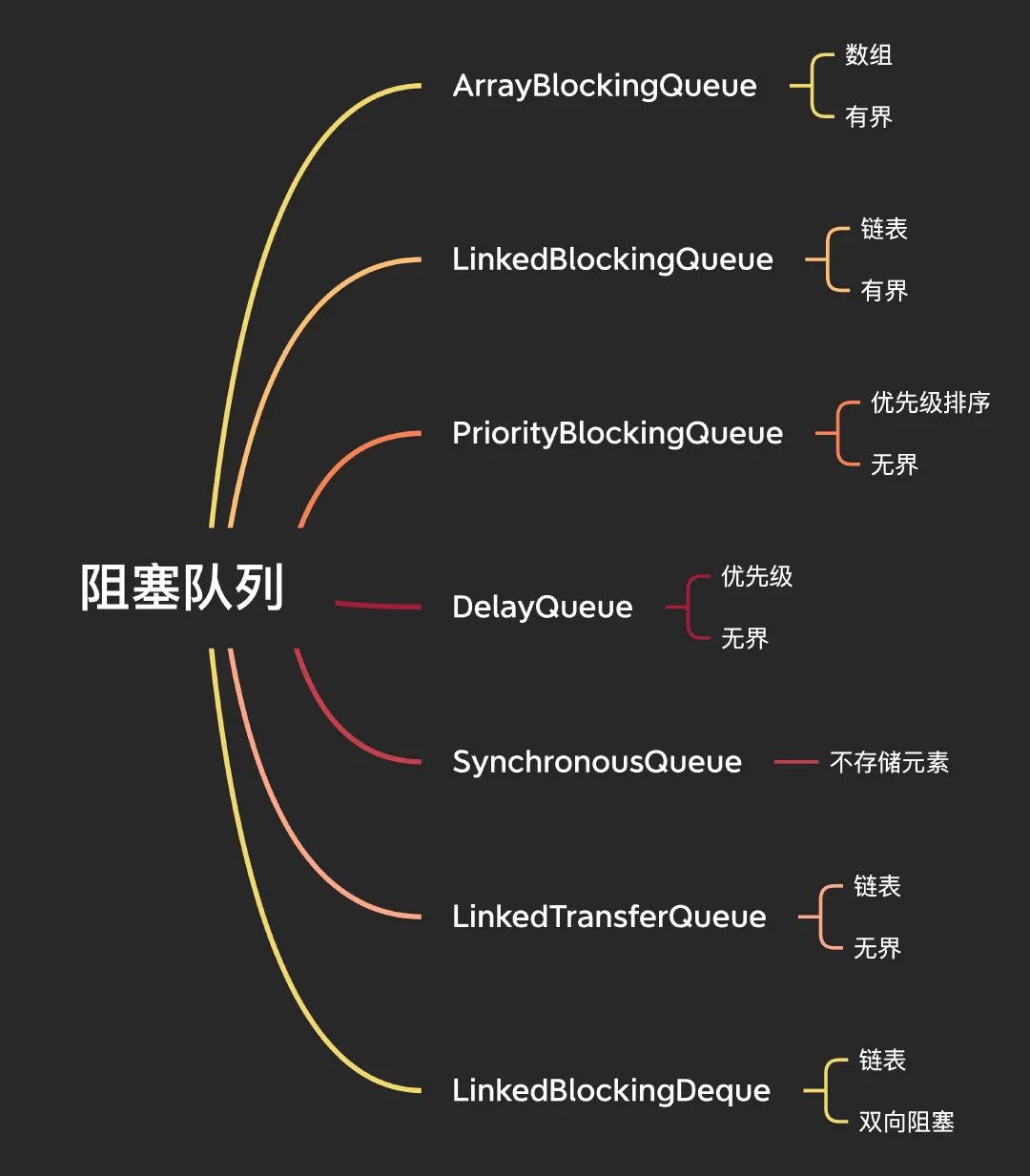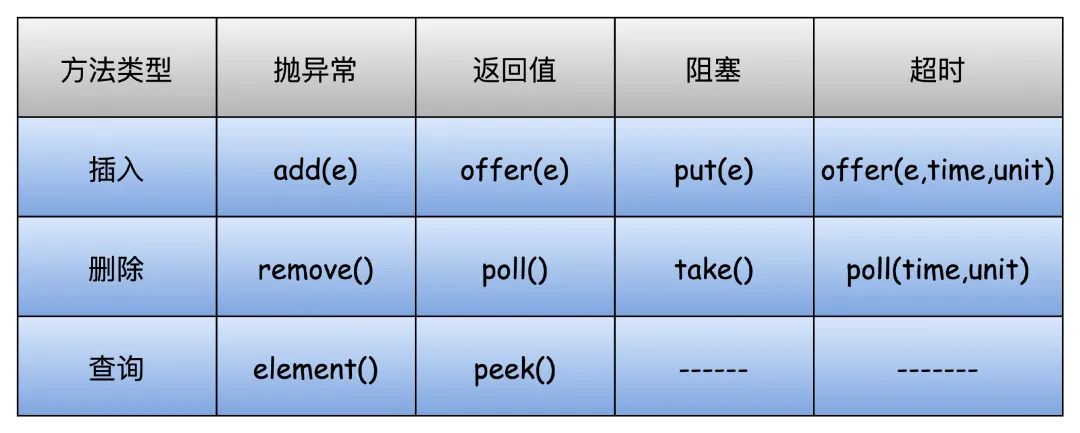阻塞队列
并发编程中,队列是其中不可缺少的一环,其实前面在说到线程池的时候,就已经提及到了阻塞队列了,这里我们要一起看看 JUC 包下提供的这些队列。
阻塞队列
阻塞队列中的阻塞包含两层意思:
- 插入的时候,如果阻塞队列满,插入元素阻塞
- 删除/查询的时候,如果阻塞队列空,删除/查询元素阻塞
下面列出队列的一些插入和删除元素的方法,一个个来说:
add:向队列尾部插入元素,插入成功返回 true,队列满则抛出IllegalStateException("Queue full")异常
offer:向队列尾部插入元素,队列满返回 false,否则返回 true,带超时的则是会阻塞,达到超时时间后返回
put:向队列尾部插入元素,队列满会一直阻塞
remove:删除队列头部元素,删除成功返回 true,队列空则抛出NoSuchElementException异常
poll:删除队列头部元素,删除成功返回队列头部元素,队列空返回null,带超时的则是会阻塞,达到超时时间后返回
take:删除队列头部元素,队列空会一直阻塞
element:查询队列头部元素,并且返回,队列空则抛出NoSuchElementException异常
peek:查询队列头部元素,并且返回
ArrayBlockingQueue
ArrayBlockingQueue 从名字就知道,基于数组实现的有界阻塞队列,基于AQS支持公平和非公平策略。
还是看构造函数吧,可以传入初始数组大小,一旦设置之后大小就不能改变了,传参可以支持公平和非公平,最后一个构造函数可以支持传入集合进行初始化,但是长度不能超过 capacity,否则抛出ArrayIndexOutOfBoundsException异常。
public ArrayBlockingQueue(int capacity); public ArrayBlockingQueue(int capacity, boolean fair); public ArrayBlockingQueue(int capacity, boolean fair, Collection<? extends E> c);
这个其实在上面介绍 Condition 的时候我们就已经实现过他了,这里就不再说了,可以参考上面 Condition 的部分。
LinkedBlockingQueue
LinkedBlockingQueue 基于链表实现的有界阻塞队列。
使用无参构造函数则链表长度为 Integer.MAX_VALUE,另外两个构造函数和 ArrayBlockingQueue 差不多。
public LinkedBlockingQueue(); public LinkedBlockingQueue(int capacity); public LinkedBlockingQueue(Collection<? extends E> c);
我们可以看看 put 和 take 的源码。
- 首先加锁中断
- 然后判断如果达到了队列的最大长度,那么就阻塞等待,否则就把元素插入到队列的尾部
- 注意这里和 ArrayBlockingQueue 有个区别,这里再次做了一次判断,如果队列没满,唤醒因为 put 阻塞的线程,为什么要做判断,因为他们不是一把锁
- 最后的逻辑是一样的,notEmpty 唤醒
public void put(E e) throws InterruptedException { if (e == null) throw new NullPointerException(); int c = -1; Node<E> node = new Node<E>(e); final ReentrantLock putLock = this.putLock; final AtomicInteger count = this.count; putLock.lockInterruptibly(); try { while (count.get() == capacity) { notFull.await(); } enqueue(node); c = count.getAndIncrement(); if (c + 1 < capacity) notFull.signal(); } finally { putLock.unlock(); } if (c == 0) signalNotEmpty(); } private void enqueue(Node<E> node) { // assert putLock.isHeldByCurrentThread(); // assert last.next == null; last = last.next = node; } private void signalNotEmpty() { final ReentrantLock takeLock = this.takeLock; takeLock.lock(); try { notEmpty.signal(); } finally { takeLock.unlock(); } }
take的逻辑也是非常类似啊。
- 加锁中断
- 判断队列是不是空了,空了的话就阻塞等待,否则就从队列移除一个元素
- 然后再次做一次判断,队列要是不空,就唤醒阻塞的线程
- 最后唤醒 notFull 的线程
public E take() throws InterruptedException { E x; int c = -1; final AtomicInteger count = this.count; final ReentrantLock takeLock = this.takeLock; takeLock.lockInterruptibly(); try { while (count.get() == 0) { notEmpty.await(); } x = dequeue(); c = count.getAndDecrement(); if (c > 1) notEmpty.signal(); } finally { takeLock.unlock(); } if (c == capacity) signalNotFull(); return x; } private E dequeue() { // assert takeLock.isHeldByCurrentThread(); // assert head.item == null; Node<E> h = head; Node<E> first = h.next; h.next = h; // help GC head = first; E x = first.item; first.item = null; return x; } private void signalNotFull() { final ReentrantLock putLock = this.putLock; putLock.lock(); try { notFull.signal(); } finally { putLock.unlock(); } }
PriorityBlockingQueue
PriorityBlockingQueue 是支持优先级的无界阻塞队列,默认排序按照自然排序升序排列。
几个构造函数,无参构造函数初始容量为11,可以自定义,也可以在创建的时候传入 comparator 自定义排序规则。
public PriorityBlockingQueue(); public PriorityBlockingQueue(int initialCapacity); public PriorityBlockingQueue(int initialCapacity, Comparator<? super E> comparator); public PriorityBlockingQueue(Collection<? extends E> c);
直接看 put 和 take 方法吧,后面都这样,其他的就忽略好了,找到 put 之后,发现直接就是调用的 offer,那我们就直接看 offer 的实现。
- 首先还是加锁,然后看当前元素个数是否达到了数组的上限,到了就调用 tryGrow 去扩容。
- 看是否实现了 Comparator 接口,是的话就用 Comparator 去排序,否则就用 Comparable 去比较,如果两个都没有,会报错
- notEmpty 唤醒,最后解锁
public void put(E e) { offer(e); // never need to block } public boolean offer(E e) { if (e == null) throw new NullPointerException(); final ReentrantLock lock = this.lock; lock.lock(); int n, cap; Object[] array; while ((n = size) >= (cap = (array = queue).length)) tryGrow(array, cap); try { Comparator<? super E> cmp = comparator; if (cmp == null) siftUpComparable(n, e, array); else siftUpUsingComparator(n, e, array, cmp); size = n + 1; notEmpty.signal(); } finally { lock.unlock(); } return true; }
这里,我们要继续关注一下这个扩容的逻辑,到底是怎么处理的?代码不长,但是看着很方的样子。
- 首先,先释放锁,因为下面用 CAS 处理,估计怕扩容时间太长阻塞的线程太多
- 然后 CAS 修改 allocationSpinLock 为1
- CAS 成功的话,进行扩容的逻辑,如果长度小于64就扩容一倍,否则扩容一半
- 之前我们说他无界,其实不太对,这里就判断是否超过了最大长度,MAX_ARRAY_SIZE = Integer.MAX_VALUE - 8,判断一下有可能会抛出内存溢出异常
- 然后创建一个新的对象数组,并且 allocationSpinLock 重新恢复为0
- 执行了一次 Thread.yield(),让出 CPU,因为有可能其他线程正在扩容,让大家争抢一下
- 最后确保新的对象数组创建成功了,也就是扩容是没有问题的,再次加锁,数组拷贝,结束
private void tryGrow(Object[] array, int oldCap) { lock.unlock(); // must release and then re-acquire main lock Object[] newArray = null; if (allocationSpinLock == 0 && UNSAFE.compareAndSwapInt(this, allocationSpinLockOffset, 0, 1)) { try { int newCap = oldCap + ((oldCap < 64) ? (oldCap + 2) : // grow faster if small (oldCap >> 1)); if (newCap - MAX_ARRAY_SIZE > 0) { // possible overflow int minCap = oldCap + 1; if (minCap < 0 || minCap > MAX_ARRAY_SIZE) throw new OutOfMemoryError(); newCap = MAX_ARRAY_SIZE; } if (newCap > oldCap && queue == array) newArray = new Object[newCap]; } finally { allocationSpinLock = 0; } } if (newArray == null) // back off if another thread is allocating Thread.yield(); lock.lock(); if (newArray != null && queue == array) { queue = newArray; System.arraycopy(array, 0, newArray, 0, oldCap); } }
take 的逻辑基本一样,最多有个排序的逻辑在里面,就不再多说了。
public E take() throws InterruptedException { final ReentrantLock lock = this.lock; lock.lockInterruptibly(); E result; try { while ( (result = dequeue()) == null) notEmpty.await(); } finally { lock.unlock(); } return result; }
DelayQueue
DelayQueue 是支持延时的无界阻塞队列,这个在我们聊 ScheduledThreadPoolExecutor 也谈到过,里面也使用了延迟队列,只不过是它自己的一个内部类,DelayQueue 内部其实使用 PriorityQueue 来实现。
DelayQueue 的用法是添加元素的时候可以设置一个延迟时间,当时间到了之后才能从队列中取出来,使用 DelayQueue 中的对象必须实现 Delayed 接口,重写 getDelay 和 compareTo 方法,就像这样,那实现其实可以看 ScheduledThreadPoolExecutor 里面是怎么做的,这里我就不管那么多,示意一下就好了。
public class Test { public static void main(String[] args) throws Exception { DelayQueue<User> delayQueue = new DelayQueue<>(); delayQueue.put(new User(1, "a")); } @Data @NoArgsConstructor @AllArgsConstructor static class User implements Delayed { private Integer id; private String username; @Override public long getDelay(TimeUnit unit) { return 0; } @Override public int compareTo(Delayed o) { return 0; } } }
我们可以看看他的属性和构造函数,呐看到了吧,使用的 PriorityQueue,另外构造函数比较简单了,不说了。
private final transient ReentrantLock lock = new ReentrantLock(); private final PriorityQueue<E> q = new PriorityQueue<E>(); private Thread leader = null; private final Condition available = lock.newCondition(); public DelayQueue(); public DelayQueue(Collection<? extends E> c);
OK,没啥毛病,这里我们要先看 take 方法,不能先看 put,否则我觉得闹不明白。
- 来第一步加锁,如果头结点是空的,也就是队列是空的话,阻塞,没啥好说的
- 反之队列有东西,我们就要去取了嘛,但是这里要看对象自己实现的 getDelay 方法获得延迟的时间,如果延迟的时间小于0,那说明到时间了,可以执行了,poll 返回
- 第一次,leader 线程肯定是空的,线程阻塞 delay 的时间之后才开始执行,完全没毛病,然后 leader 重新 置为 null
- 当 leader 不是 null 的时候,说明其他线程在操作了,所以阻塞等待唤醒
- 最后,leader 为 null,唤醒阻塞中的线程,解锁
public E take() throws InterruptedException { final ReentrantLock lock = this.lock; lock.lockInterruptibly(); try { for (;;) { E first = q.peek(); if (first == null) available.await(); else { long delay = first.getDelay(NANOSECONDS); if (delay <= 0) return q.poll(); first = null; // don't retain ref while waiting if (leader != null) available.await(); else { Thread thisThread = Thread.currentThread(); leader = thisThread; try { available.awaitNanos(delay); } finally { if (leader == thisThread) leader = null; } } } } } finally { if (leader == null && q.peek() != null) available.signal(); lock.unlock(); } }
然后再来看 put 就会简单多了,put 还是直接调用的 offer,看 offer 方法。
这里使用的是 PriorityQueue 的 offer 方法,其实和我们上面说到的 PriorityBlockingQueue 差不多,不再多说了,添加到队列头部之后,leader 置为 null,唤醒,结束了。
public boolean offer(E e) { final ReentrantLock lock = this.lock; lock.lock(); try { q.offer(e); if (q.peek() == e) { leader = null; available.signal(); } return true; } finally { lock.unlock(); } }
SynchronousQueue&LinkedTransferQueue
为什么这两个放一起说呢。。。因为这源码真的不想在这里说一遍,这俩源码可以单独出一个专题来写,长篇精悍文章不适合他他们,就简单先了解下。
SynchronousQueue 是一个不存储元素的阻塞队列,每个 put 必须等待 take,否则不能继续添加元素。
如果你还记得我们上面说到线程池的地方,newCachedThreadPool 默认就是使用的 SynchronousQueue。
他就两个构造方法,你一看就知道,对吧,支持公平和非公平,当然你也别问默认是啥,问就是非公平。
public SynchronousQueue(); public SynchronousQueue(boolean fair);
主要靠内部抽象类 Transferer,他的实现主要有两个,TransferQueue 和 TransferStack。
注意:如果是公平模式,使用的是 TransferQueue 队列,非公平则使用 TransferStack 栈。
abstract static class Transferer<E> { abstract E transfer(E e, boolean timed, long nanos); }
LinkedTransferQueue 是链表组成的无界阻塞队列,看他内部类就知道了,这是个链表实现。
static final class Node { final boolean isData; // 标记生产者或者消费者 volatile Object item; // 值 volatile Node next; // 下一个节点 volatile Thread waiter; }
LinkedBlockingDeque
LinkedBlockingDeque 是链表组成的双向阻塞队列,它支持从队列的头尾进行进行插入和删除元素。
构造函数有3个,不传初始容量就是 Integer 最大值。
public LinkedBlockingDeque() { this(Integer.MAX_VALUE); } public LinkedBlockingDeque(int capacity); public LinkedBlockingDeque(Collection<? extends E> c);
看下双向链表的结构:
static final class Node<E> { E item; Node<E> prev; Node<E> next; Node(E x) { item = x; } }
因为是双向链表,所以比其他的队列多了一些方法,比如 add、addFirst、addLast,add 其实就是 addLast,offer、put 也是类似。
我们可以区分看一下 putFirst 和 putLast ,主要区别就是 linkFirst 和 linkLast,分别去队列头部和尾部添加新节点,其他基本一致。
public void putFirst(E e) throws InterruptedException { if (e == null) throw new NullPointerException(); Node<E> node = new Node<E>(e); final ReentrantLock lock = this.lock; lock.lock(); try { while (!linkFirst(node)) notFull.await(); } finally { lock.unlock(); } } public void putLast(E e) throws InterruptedException { if (e == null) throw new NullPointerException(); Node<E> node = new Node<E>(e); final ReentrantLock lock = this.lock; lock.lock(); try { while (!linkLast(node)) notFull.await(); } finally { lock.unlock(); } }
结尾
本次长篇内容参考书籍和文档
- Java 并发编程的艺术
- Java 并发编程之美
- Java 并发编程实战
- Java 8实战
- 极客时间:Java 并发编程实战



